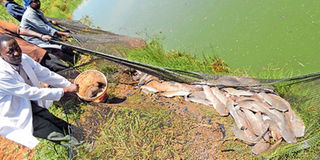Lessons for fish dealers

Joseph Mutwiri displays fish harvested from his pond in Meru in this past photo. Catfish, common carp, tilapia and trout are the most preferred fish species for farming across the country. FILE PHOTO | NMG
What you need to know:
- Catfish and common carp, tilapia and trout are the preferred fish species
- Most of the traders (71 per cent) used racks to dry the fish for preservation while 29 per cent stored fish in freezers as recommended.
- When it came to disposal of fish waste, the internal organs were fed to dogs while bones were either crushed and fed to poultry or were incinerated together with scales and added to compost for provision of calcium and ash.
- To contribute to environmental conservation, the traders were encouraged to use sawdust jikos as these were utilising waste for cooking energy supply.
A study by researchers from the College of Agriculture and Veterinary Medicine, University of Nairobi, opens the lid on the happenings in the fish sector across the value chain.
The recent study examined 19 fish kiosks in Nyandarua County to establish the safety status of fish along the value chain, from harvesting, through transportation, to consumption. These are the findings:
Demographic traits
Some 70 per cent of the traders were male while 57 per cent and 43 per cent had primary and secondary education respectively.
Age-wise, 42 per cent, 42 per cent and 16 per cent were 18 to 35 years (youth), 36-45 years and over 45 years respectively.
This shows that gender and age are not a limitation in fish trade in the country. However, graduates and postgraduates are not in the trade as they prefer white-collar jobs.
Type of fish traded
Catfish and common carp, tilapia and trout are the preferred fish species – in that order. Catfish, tilapia and trout are sourced from within the county while common carp was from a neighbouring devolved unit.
This is an indication of cross-county trade and hence a need to synchronise policies among counties.
Time in the business
A majority of the traders (57 per cent) had one-year experience in the fish business while 29 per cent and 14 per cent had two and three respectively.
This indicated that the fish business was gaining popularity in Nyandarua, pushed by increased demand.
Daily trade volumes
Most of the traders (86 per cent) sourced for over 10kg of fish daily while the rest bought between 5 and 10kg per day.
Transport means
The majority (44 per cent) ferried fish in sacks and buckets while 12 per cent used cool boxes. This calls for traders to invest in cool boxes – the recommended method of transport for small-scale traders.
Storage of raw fish
Most of the traders (71 per cent) used racks to dry the fish for preservation while 29 per cent stored fish in freezers as recommended.
This implies that the preservation method is limiting to the trade as the traders with no freezers could only procure a day’s consignment.
This in turn forces them to travel to buy every day, increasing the cost of doing business. On the other hand, those who had freezers could purchase a whole week’s consignment due to the effective preservation method.
State of hygiene
In most of the premises, (70 per cent), they appeared in need of some cleaning while the rest were termed as clean.
When it came to disposal of fish waste, the internal organs were fed to dogs while bones were either crushed and fed to poultry or were incinerated together with scales and added to compost for provision of calcium and ash.
The disposal methods were found to be satisfactory.
Source/quality of water
Water sources included piped water (57 per cent), borehole (29 per cent) and river (14 per cent) while 71 per cent of the respondents indicated that they received adequate supply of water.
Piped and borehole water is often of good quality. However, river water requires purification.
Cooking fuel
The majority (57 per cent) used charcoal while 29 per cent and 14 per cent used wood or saw dust jikos and improved jikos respectively.
To contribute to environmental conservation, the traders were encouraged to use sawdust jikos as these were utilising waste for cooking energy supply.
Products on sale
Apart from fish meat, some traders (57 per cent) were also able to extract fish oil for sale. In one impressive outlet, schoolchildren dropped by for a spoonful of oil daily at Sh15.
Soup at Sh20 per cup was another product. Common carp fish eggs were a delicacy in some of the outlets.
Bacteria in fish
The survey demonstrated presence of bacteria in most fish samples taken from farms that did not store their produce in freezers, outlets that hang fish; where it is transported in sacks, in those where fish was not well cooked and in those where one person handled both fish and money.
The study recommended a separation of duties, with the cashier as a different person from the one handling fish.
Dr Mwirigi, [email protected]




